2014 Peugeot Boxer engine oil
[x] Cancel search: engine oilPage 12 of 240
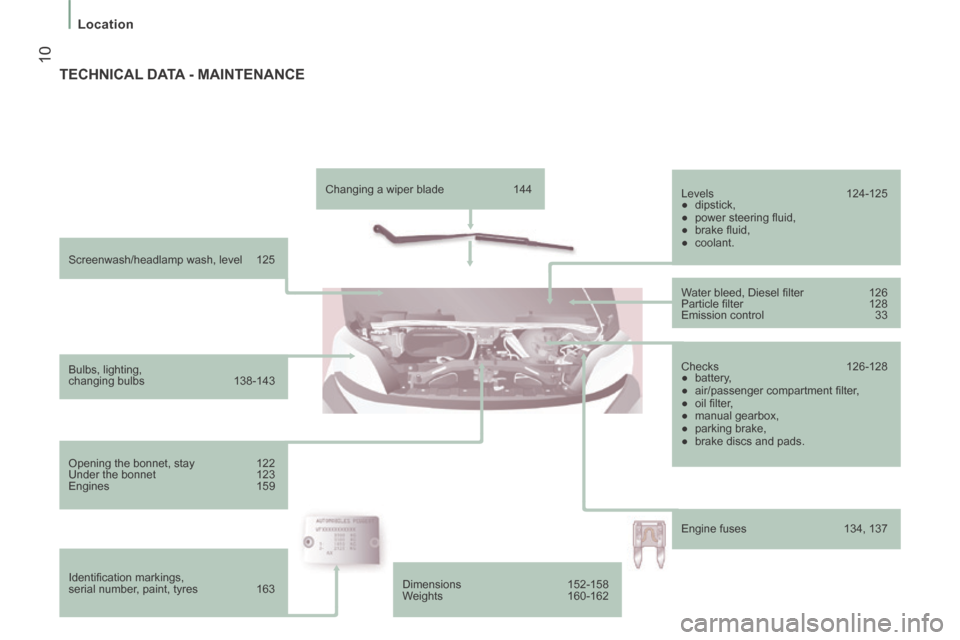
10
Location
Screenwash/headlamp wash, level 125
Bulbs, lighting,
changing bulbs 138-143
Opening the bonnet, stay 122
Under the bonnet 123
Engines 159
Identifi cation markings,
serial number, paint, tyres 163 Changing a wiper blade
144
Levels 124-125
● dipstick,
● power steering fl uid,
● brake fl uid,
● coolant.
Water bleed, Diesel fi lter 126
Particle fi lter 128
Emission control 33
Checks 126-128
● battery,
● air/passenger compartment fi lter,
● oil fi lter,
● manual gearbox,
● parking brake,
● brake discs and pads.
Engine fuses 134, 137
TECHNICAL DATA - MAINTENANCE
Dimensions 152-158
Weights 160-162
Page 13 of 240
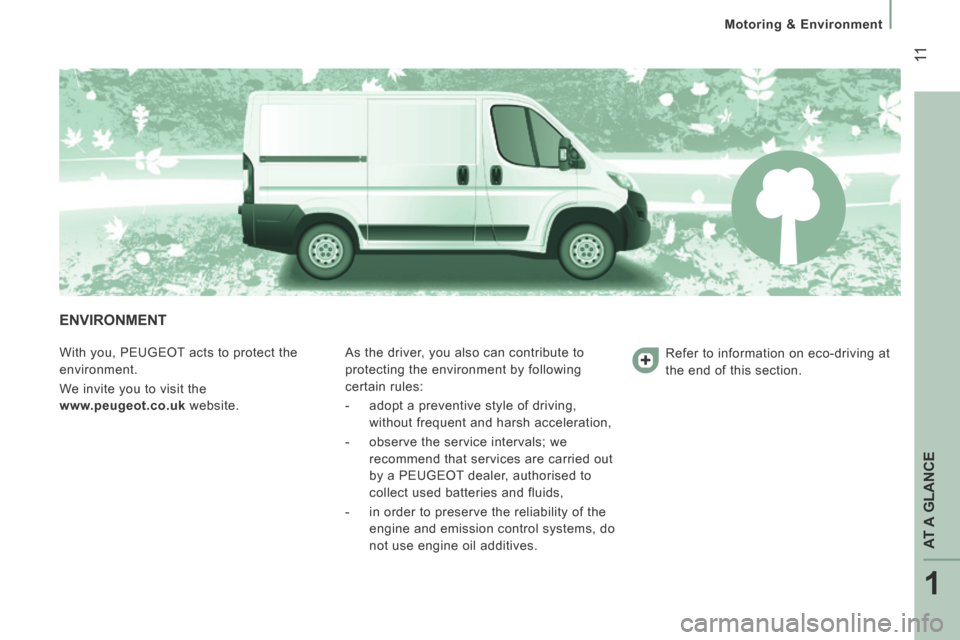
1
AT A GLANCE
11
Motoring & Environment
ENVIRONMENT
With you, PEUGEOT acts to protect the
environment.
We invite you to visit the
www.peugeot.co.uk website. As the driver, you also can contribute to
protecting the environment by following
certain rules:
- adopt a preventive style of driving,
without frequent and harsh acceleration,
- observe the service intervals; we recommend that services are carried out
by a PEUGEOT dealer, authorised to
collect used batteries and fluids,
- in order to preserve the reliability of the engine and emission control systems, do
not use engine oil additives. Refer to information on eco-driving at
the end of this section.
Page 15 of 240
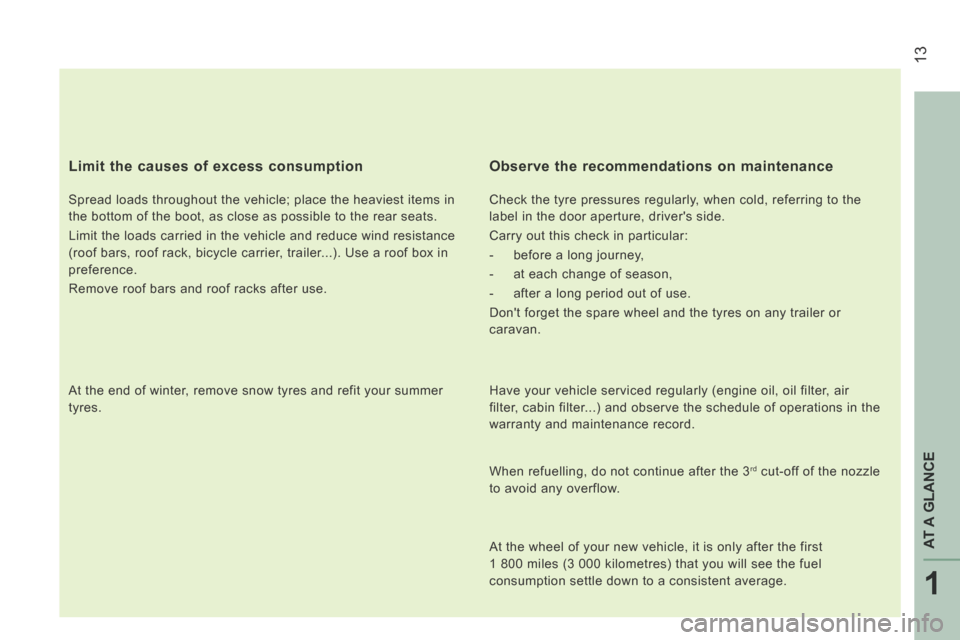
13
1
AT A GLANCE
Limit the causes of excess consumption
Spread loads throughout the vehicle; place the heaviest items in
the bottom of the boot, as close as possible to the rear seats.
Limit the loads carried in the vehicle and reduce wind resistance
(roof bars, roof rack, bicycle carrier, trailer...). Use a roof box in
preference.
Remove roof bars and roof racks after use.
At the end of winter, remove snow tyres and refit your summer
tyres.
Observe the recommendations on maintenance
Check the tyre pressures regularly, when cold, referring to the
label in the door aperture, driver's side.
Carry out this check in particular:
- before a long journey,
- at each change of season,
- after a long period out of use.
Don't forget the spare wheel and the tyres on any trailer or
caravan.
Have your vehicle serviced regularly (engine oil, oil filter, air
filter, cabin filter...) and observe the schedule of operations in the
warranty and maintenance record.
When refuelling, do not continue after the 3
rd cut-off of the nozzle
to avoid any overflow.
At the wheel of your new vehicle, it is only after the first
1 800 miles (3 000 kilometres) that you will see the fuel
consumption settle down to a consistent average.
Page 27 of 240
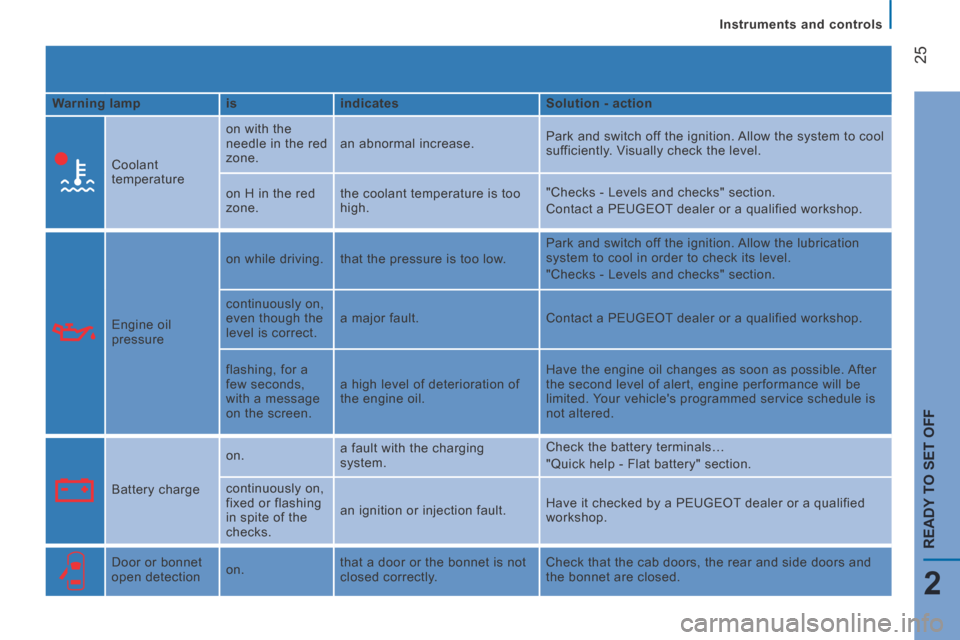
25
2
READY TO SET OFF
Instruments and controls
Warning lamp is indicates Solution - action
Coolant
temperature on with the
needle in the red
zone.
an abnormal increase.
Park and switch off the ignition. Allow the system to cool
sufficiently. Visually check the level.
on H in the red
zone. the coolant temperature is too
high. "Checks - Levels and checks" section.
Contact a PEUGEOT dealer or a qualified workshop.
Engine oil
pressure on while driving.
that the pressure is too low. Park and switch off the ignition. Allow the lubrication
system to cool in order to check its level.
"Checks - Levels and checks" section.
continuously on,
even though the
level is correct. a major fault.
Contact a PEUGEOT dealer or a qualified workshop.
flashing, for a
few seconds,
with a message
on the screen. a high level of deterioration of
the engine oil. Have the engine oil changes as soon as possible. After
the second level of alert, engine performance will be
limited. Your vehicle's programmed service schedule is
not altered.
Battery charge on.
a fault with the charging
system. Check the battery terminals…
"Quick help - Flat battery" section.
continuously on,
fixed or flashing
in spite of the
checks. an ignition or injection fault.
Have it checked by a PEUGEOT dealer or a qualified
workshop.
Door or bonnet
open detection on. that a door or the bonnet is not
closed correctly. Check that the cab doors, the rear and side doors and
the bonnet are closed.
Page 37 of 240
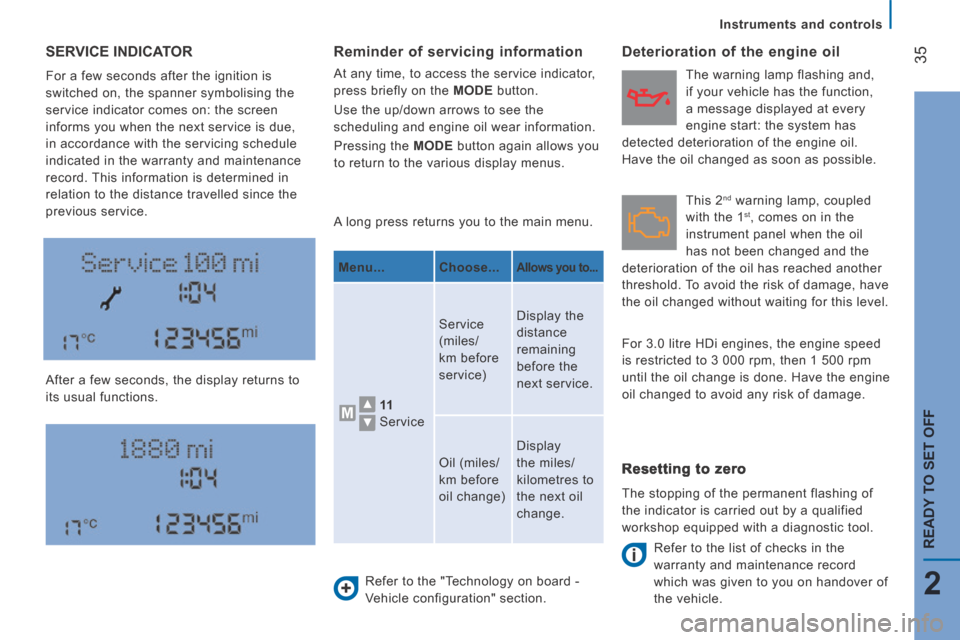
35
2
READY TO SET OFF
Instruments and controls
SERVICE INDICATOR
For a few seconds after the ignition is
switched on, the spanner symbolising the
service indicator comes on: the screen
informs you when the next service is due,
in accordance with the servicing schedule
indicated in the warranty and maintenance
record. This information is determined in
relation to the distance travelled since the
previous service.
After a few seconds, the display returns to
its usual functions. A long press returns you to the main menu.
Refer to the "Technology on board -
Vehicle configuration" section.
Deterioration of the engine oil
Refer to the list of checks in the
warranty and maintenance record
which was given to you on handover of
the vehicle.
Reminder of servicing information
At any time, to access the service indicator,
press briefly on the MODE button.
Use the up/down arrows to see the
scheduling and engine oil wear information.
Pressing the MODE button again allows you
to return to the various display menus.
Menu... Choose...
Allows you to...
11
Service Service
(miles/
km before
service)
Display the
distance
remaining
before the
next service.
Oil (miles/
km before
oil change) Display
the miles/
kilometres to
the next oil
change.
Resetting to zero
The stopping of the permanent flashing of
the indicator is carried out by a qualified
workshop equipped with a diagnostic tool. This 2
nd warning lamp, coupled
with the 1 st , comes on in the
instrument panel when the oil
has not been changed and the
deterioration of the oil has reached another
threshold. To avoid the risk of damage, have
the oil changed without waiting for this level. The warning lamp flashing and,
if your vehicle has the function,
a message displayed at every
engine start: the system has
detected deterioration of the engine oil.
Have the oil changed as soon as possible.
For 3.0 litre HDi engines, the engine speed
is restricted to 3 000 rpm, then 1 500 rpm
until the oil change is done. Have the engine
oil changed to avoid any risk of damage.
Page 125 of 240
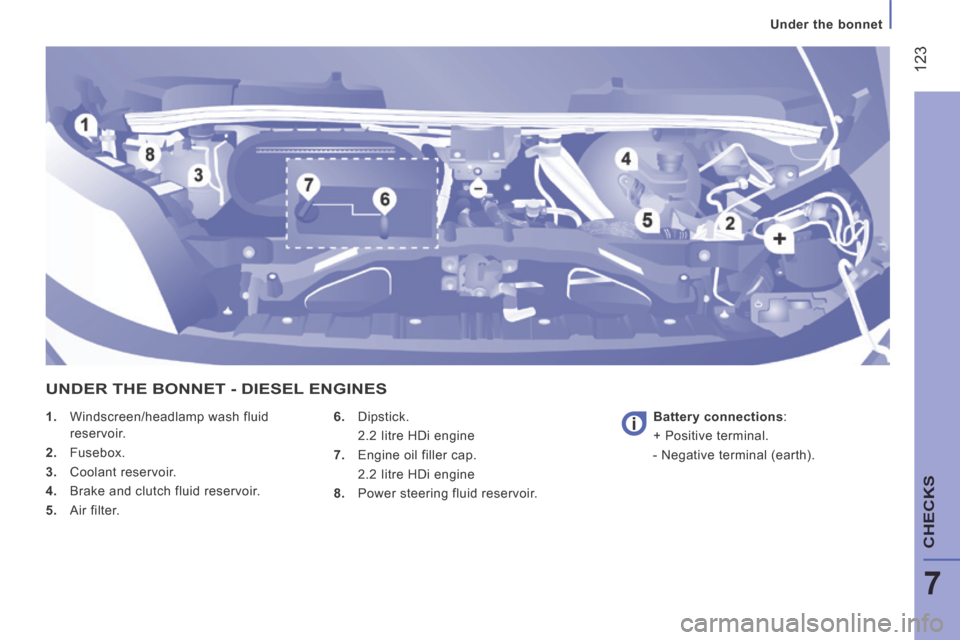
123
7
Under the bonnet
CHECKS
1. Windscreen/headlamp wash fluid reservoir.
2. Fusebox.
3. Coolant reservoir.
4. Brake and clutch fluid reservoir.
5. Air filter. 6. Dipstick.
2.2 Iitre HDi engine
7. Engine oil filler cap.
2.2 Iitre HDi engine
8. Power steering fluid reservoir.
Battery connections :
+ Positive terminal.
- Negative terminal (earth).
UNDER THE BONNET - DIESEL ENGINES
Page 126 of 240
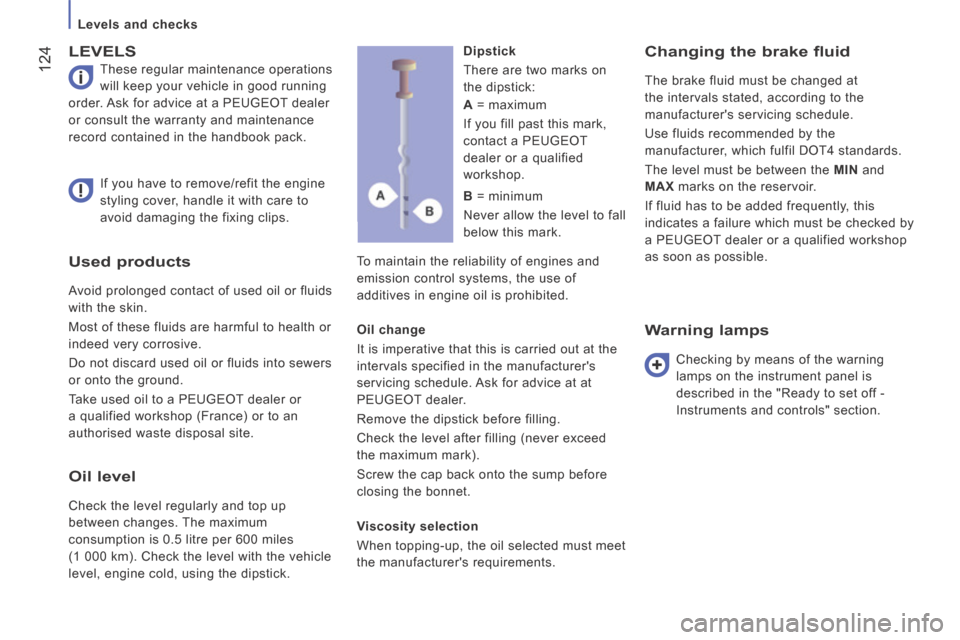
124
Levels and checks
Used products
Avoid prolonged contact of used oil or fluids
with the skin.
Most of these fluids are harmful to health or
indeed very corrosive.
Do not discard used oil or fluids into sewers
or onto the ground.
Take used oil to a PEUGEOT dealer or
a qualified workshop (France) or to an
authorised waste disposal site.
LEVELS
These regular maintenance operations
will keep your vehicle in good running
order. Ask for advice at a PEUGEOT dealer
or consult the warranty and maintenance
record contained in the handbook pack.
To maintain the reliability of engines and
emission control systems, the use of
additives in engine oil is prohibited.
Changing the brake fluid
The brake fluid must be changed at
the intervals stated, according to the
manufacturer's servicing schedule.
Use fluids recommended by the
manufacturer, which fulfil DOT4 standards.
The level must be between the MIN and
MAX marks on the reservoir.
If fluid has to be added frequently, this
indicates a failure which must be checked by
a PEUGEOT dealer or a qualified workshop
as soon as possible.
If you have to remove/refit the engine
styling cover, handle it with care to
avoid damaging the fixing clips. Dipstick
There are two marks on
the dipstick:
Oil change
It is imperative that this is carried out at the
intervals specified in the manufacturer's
servicing schedule. Ask for advice at at
PEUGEOT dealer.
Remove the dipstick before filling.
Check the level after filling (never exceed
the maximum mark).
Screw the cap back onto the sump before
closing the bonnet.
Viscosity selection
When topping-up, the oil selected must meet
the manufacturer's requirements.
Warning lamps
Checking by means of the warning
lamps on the instrument panel is
described in the "Ready to set off -
Instruments and controls" section.
A
= maximum
If you fill past this mark,
contact a PEUGEOT
dealer or a qualified
workshop.
B = minimum
Never allow the level to fall
below this mark.
Oil level
Check the level regularly and top up
between changes. The maximum
consumption is 0.5 litre per 600 miles
(1 000 km). Check the level with the vehicle
level, engine cold, using the dipstick.
Page 128 of 240
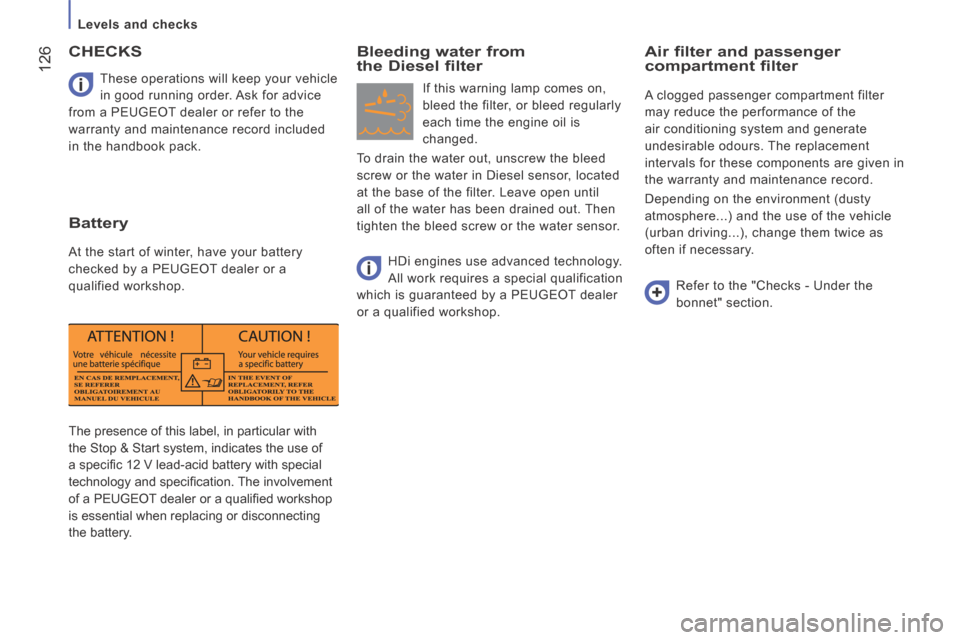
126
Levels and checks
The presence of this label, in particular with
the Stop & Start system, indicates the use of
a specifi c 12 V lead-acid battery with special
technology and specifi cation. The involvement
of a PEUGEOT dealer or a qualifi ed workshop
is essential when replacing or disconnecting
the battery. These operations will keep your vehicle
in good running order. Ask for advice
from a PEUGEOT dealer or refer to the
warranty and maintenance record included
in the handbook pack.
CHECKS
Battery
At the start of winter, have your battery
checked by a PEUGEOT dealer or a
qualified workshop.
Bleeding water from the Diesel filter
If this warning lamp comes on,
bleed the filter, or bleed regularly
each time the engine oil is
changed.
To drain the water out, unscrew the bleed
screw or the water in Diesel sensor, located
at the base of the filter. Leave open until
all of the water has been drained out. Then
tighten the bleed screw or the water sensor.
Air filter and passenger compartment filter
A clogged passenger compartment filter
may reduce the performance of the
air conditioning system and generate
undesirable odours. The replacement
intervals for these components are given in
the warranty and maintenance record.
Depending on the environment (dusty
atmosphere...) and the use of the vehicle
(urban driving...), change them twice as
often if necessary.
Refer to the "Checks - Under the
bonnet" section.
HDi engines use advanced technology.
All work requires a special qualification
which is guaranteed by a PEUGEOT dealer
or a qualified workshop.